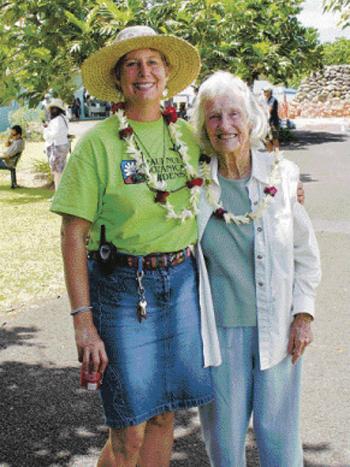A lecture and presentation on kapa tomorrow will focus on native Hawaiian plant-based dyes. Kapa is a fabric found in ancient Hawai‘i made of beaten mulberry bark, or “wauke.” Maui Nui Botanical Garden executive director, Lisa Schattenburg-Raymond, will discuss historic
A lecture and presentation on kapa tomorrow will focus on native Hawaiian plant-based dyes. Kapa is a fabric found in ancient Hawai‘i made of beaten mulberry bark, or “wauke.”
Maui Nui Botanical Garden executive director, Lisa Schattenburg-Raymond, will discuss historic aspects of kapa, with an emphasis on natural dyes. The presentation will be from 9:30 a.m. to 11:30 a.m. tomorrow at the Frear Center at Island School in Puhi.
Schattenburg-Raymond’s first exposure to kapa making was through her mother.
“When my mom went back to school one of her projects was working with dyes,” she said. “She worked with ethnobotonist, Beatrice Krauss, who wrote “Plants in Hawaiian Culture.”
Schattenburg-Raymond followed her mother’s footsteps and later attended University of Hawai‘i to study uses of Hawaiian plants. At tomorrow’s presentation she will share some of her research on traditional dyes used by ancient Hawaiians.
“Most people think of brown and black geometric designs when they think of kapa,” she said. “But that’s not Hawaiian — those are Samoan, Tongan and Fijian. Hawaiian kapa was more colorful. Early observations were that it looked like European designs — very intricate with a high quality of craftsmanship.”
It was not only brighter but the texture of the fabric was more refined.
“In Hawai‘i kapa was fermented so the quality of it was more like fine paper — the texture is much smoother.”
Schattenburg-Raymond’s focus will be on traditional dyes.
“My particular focus is on Hawaiian plants and resources they used historically. I’m focusing on historical applications — ones that I came across in the Hawaiian dictionary and how they were used. There are references to the use of dye and kapa in the dictionary. I’d make a discovery then I’d go try what I read.”
In tomorrow’s presentation she’ll share her discoveries.
“I’ll show the different process for making dyes from flowers, stems, leaves, roots, charcoal and soil,” she said. “I explain the process for turning those into dyes for kapa. It will be enough to get people grounded to do their own research.”
While indeed the native Hawaiian plants presented are ones available on all the islands, there is still room for variations in color.
“Plants on different islands yield different results,” she said. “These are general guidelines.”
The PowerPoint presentation will cover her research into traditional dyes, what was used and how they were prepared, and then finish with a look at some of the contemporary kapa maker’s work. Some photos of kapa from Captain Cook’s collection are from Kaua‘i.
“Captain Cook was gifted quite a number of pieces,” she said. “That’s snap shot in time.”
There will not be any hands-on demonstrations but Schattenburg-Raymond will show techniques she uses to make dyes. The actual making of kapa is no small endeavor — from growing the wauke plant carefully in order to get a long straight piece, to the harvest, stripping with opihi shell, right down to the weeks required for fermentation.
“It’s a mind blowingly long and complicated process,” she said. “For clothing (Hawaiians) could make it light like lace — there’s techniques of rubbing with a smooth stone to buff it or shine it so it’s more like flannel.”
Schattenburg-Raymond uses alternative textiles like “masi” or unbleached muslin.
“Mostly for my research I use a Fijian kapa called masi,” she said. “In teaching we use an unbleached muslin.”
The book of recipes she’s compiled is for the hula halau community.
“The halau’s are looking for authentic costuming — to incorporate the plants that are in the mele or the colors are reflective of the mele. It adds another level to the performance. Kapa you wore were some how connected to the person or the god that they were honoring.”
Following the presentation will be a potluck lunch. There is a $10 donation to defray travel expenses. Contact Sabra Kauka, 246.8899.
Pam Woolway, lifestyle writer, can be reached at 245-3681, ext. 257 or pwoolway@kauaipubco.com


